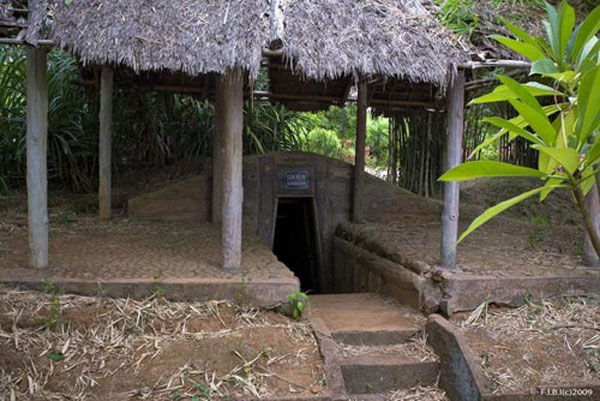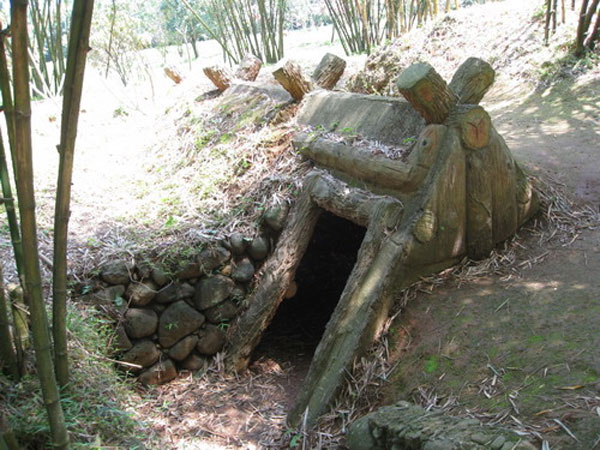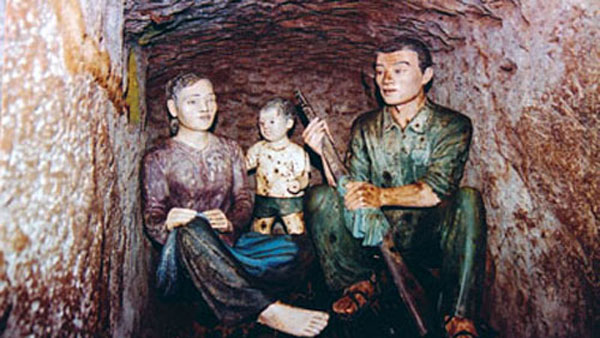Vinh Moc Tunnel- a world beneath the war
 |
The war has ended and the tunnel has become a historical site. Visitors to Vinh Moc Tunnel come to better understand local people’s hardships, creativity and bravery.
Vinh Moc Tunnel is located in the Demilitarized Zone (DMZ) near Hien Luong Bridge, which divided the north and south Vietnam during the war. Few people know that under tree-shaded roads there is a tunnel system, a world where Vinh Linh civilians and soldiers lived and fought from 1965 to 1972.
Tour guide Le Thi To Hoai said, “Vinh Moc is one of 114 tunnels found in Vinh Linh District. The tunnels stretch along 42 kilometers but Vinh Moc is one of the most typical. It was shelter for hundreds of people during the war and also a station for the transportation of food and arms for Con Co Island and the southern battle. It took a year from 1966 to 1967 to dig the tunnel”.
Vinh Moc is always cool and well-aired thanks to its well-designed ventilation system, which enabled hundreds of people to live and fight through the war. Going further inside the tunnel, under torch-light, visitors can see an accurate scientific recreation of the living and working conditions there.
Local people’s creativity helped to build vitality for the tunnel and made it different. They turned the underground into a series of strong fortresses with three connected floors.
The first floor, 12 and 15 meters below the ground, was where the civilians lived. At a depth of 18 meters, the second floor served as the Headquarters of the Party Committee, the People’s Committee and Military Command.
The third floor, 22 meters below ground, was used as a warehouse for logistics, food and ammunition for Con Co Island and the civilians and soldiers in the tunnel.
 |
Director of Quang Tri Province’s Department of Culture, Sports and Tourism Nguyen Huu Thang noted, “The tunnel was used during the resistance war in northern Vietnam. Vinh Linh was the fiercest battle, so people could not live above the ground and had to move underground. They dug the tunnel to live."
"There was also a maternity hospital in the tunnel. Within a few years, 17 children were born. The tunnel was not only a military base but also an underground village where all the daily activities took place. There was also a well, a meeting room, clinics, and kitchens,” Thang added.
During the war, civilians and soldiers usually did not leave the tunnel to assure the number of combat personnel. It’s hard to imagine that there was a time when 1,200 people lived along the main 2-km axis. It exhibited the Vietnamese people’s staunch spirit during the war.
 |
Hoai shared, “Many visitors searched for information about the relic before visiting but some don’t know anything about it. They all were amazed when visiting the tunnel. Some American tourists found it unimaginable. They never imagined that with hands and rudimentary tools, Vietnamese made an anti-bomb system which could also resist modern American bombs”.
During the war, nobody could imagine that there was an underground world where people lived and fought. For foreign visitors, the Vietnamese people’s creativity and strength were epitomized in such historical sites.
An Italian tourist said, “Everything happened. I was amazed when visiting the tunnel. I really admire Vietnamese people. They are very smart. The landscape here is also beautiful”.
Vinh Moc Tunnel is one of hundreds of tunnels in Quang Tri Province that remain intact. They are now historical sites of significant value reflecting Vietnam’s history and its people’s patriotism, bravery and creativity.
What the stars mean:
★ Poor ★ ★ Promising ★★★ Good ★★★★ Very good ★★★★★ Exceptional
Latest News
More News
- The destinations powering Vietnam’s festive season travel demand (December 04, 2025 | 18:33)
- Vietnam named among the world’s most exciting winter destinations (December 04, 2025 | 15:10)
- Phu Tho emerges as northern Vietnam’s new tourism hub (December 01, 2025 | 17:00)
- Vietjet completes Airbus A320/A321 updates ahead of deadline (December 01, 2025 | 09:49)
- Vietjet resumes Con Dao flights from early December (November 28, 2025 | 15:24)
- Free tickets, Lunar New Year promotions on offer at Vietjet Mega Livestream (November 26, 2025 | 15:32)
- Scandinavian Airlines and Vietnam Airlines broaden agreement with new routes (November 25, 2025 | 17:04)
- Halong Cruise Port welcomes over 3,100 international visitors (November 12, 2025 | 18:06)
- Vietnam.travel climbs to second place in Southeast Asia website rankings (November 12, 2025 | 18:01)
- Cat Ba named among Southeast Asia’s top island adventures (November 11, 2025 | 18:09)

















 Mobile Version
Mobile Version